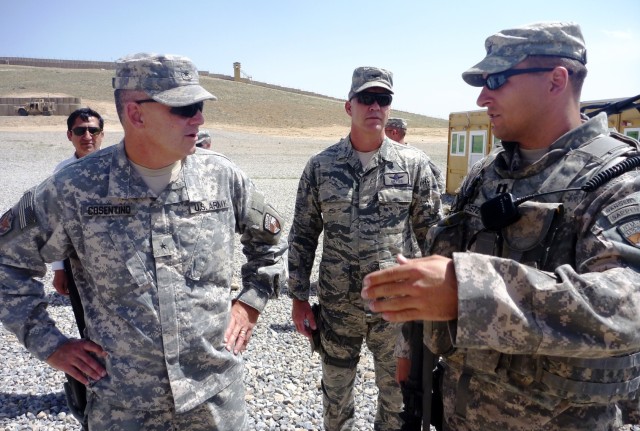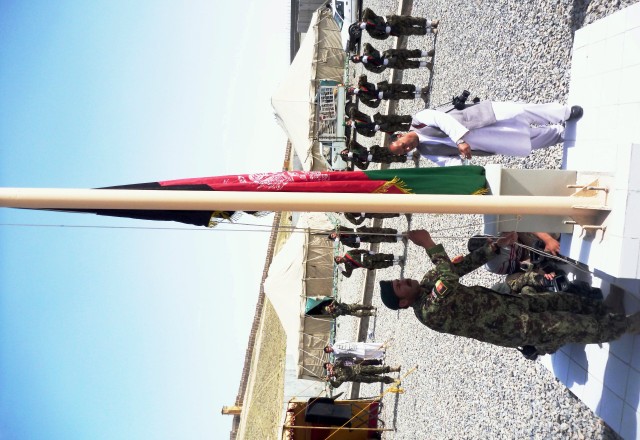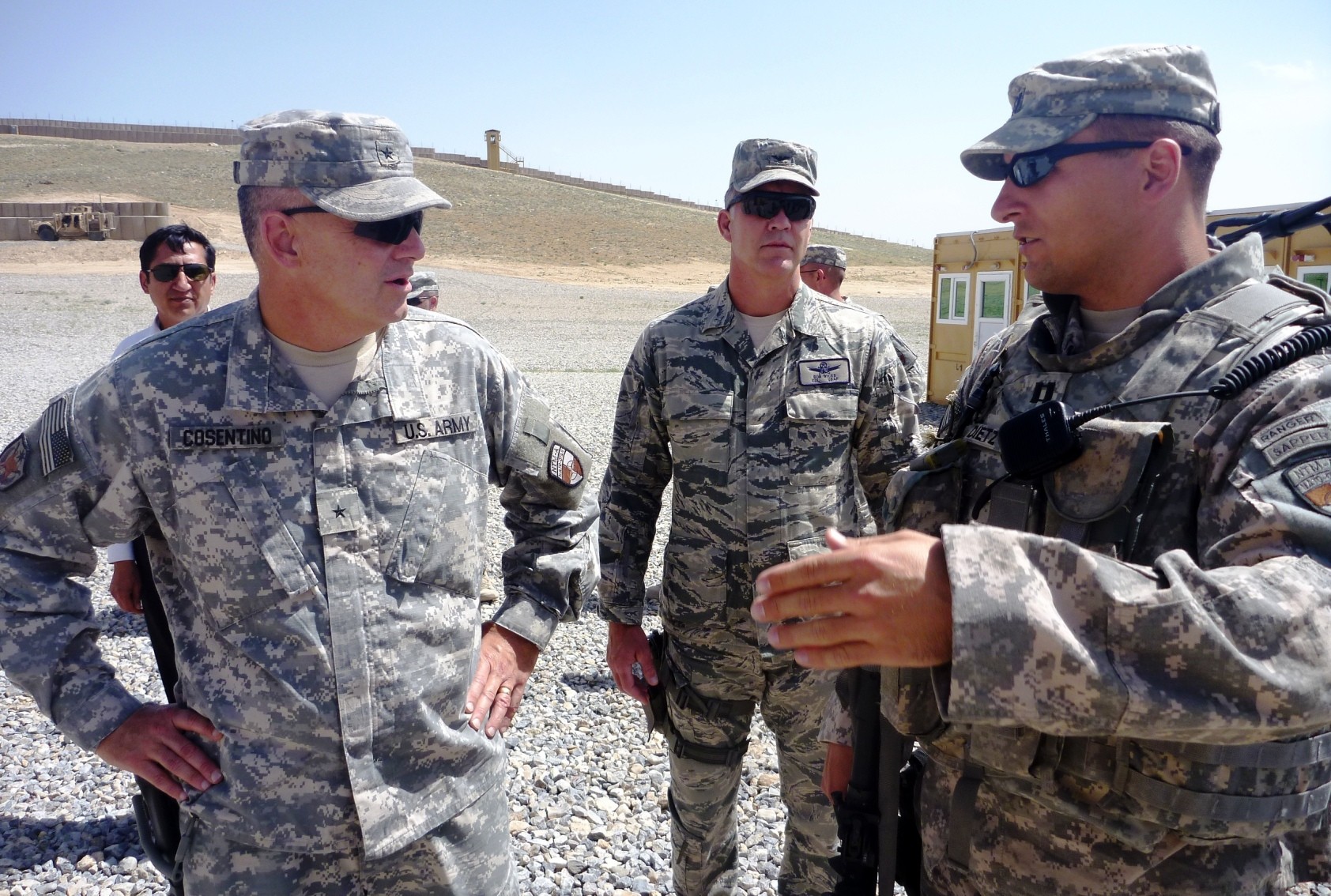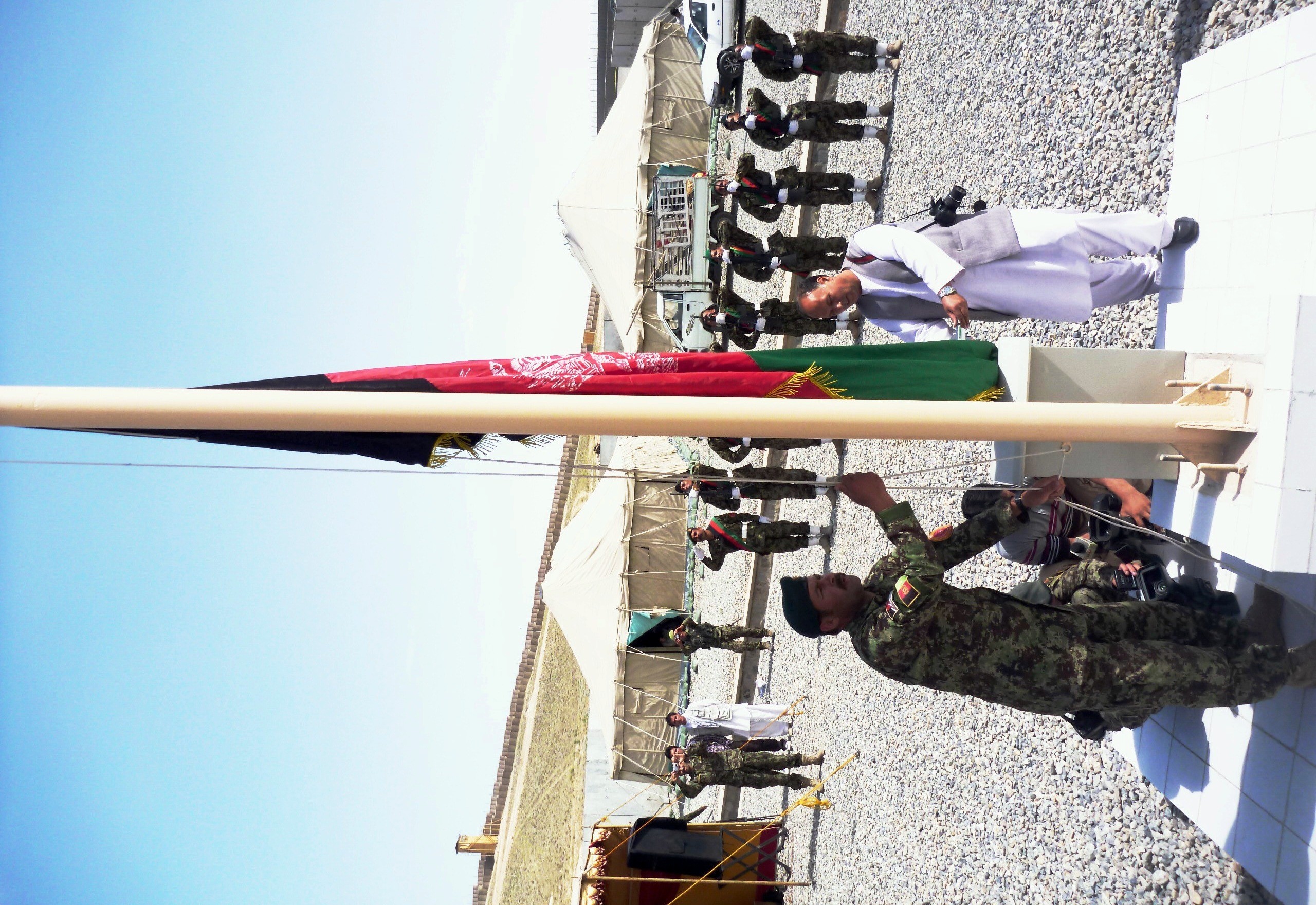FOB DEH SABZ, Afghanistan, May 14, 2011 -- As the flag went up the pole, a new chapter in Afghan history took off as the Afghan Army accepted full control of Forward Operating Base Deh Sabz.
Strategically positioned in the mountainous countryside near Kabul, Forward Operating Base, or FOB, Deh Sabz is a symbol of Afghan independence and its ability to protect citizens from insurgents. The May 12, 2011, flag-raising ceremony was a joyous occasion for all in attendance. It was a day that came to fruition after construction began last August.
"This facility is a symbol" of the friendship between Afghanistan and its coalition partners, said Brig. Gen. Tom Cosentino, deputy commander, Regional Support, NATO Training Mission-Afghanistan/Combined Security Transition Command-Afghanistan, who was one of several distinguished guests invited to speak during the ceremony.
"This may be the best FOB in Afghanistan," he said, speaking in a large red-trimmed yellow tent that had 10 red carpets placed over rocks to serve as a floor.
"The FOB strikes fear in the heads of our enemies," he said, adding that it serves as a shield for Kabul and is a dagger pointed toward insurgents.
At the end of the day, Cosentino said, this FOB is rocks and metal. But the real defense is "the brave soldiers of Afghanistan. This FOB is a gift from God to the people of Afghanistan."
During the ceremony, the Afghanistan national anthem was played via recorded music and an Afghan man performed a song a cappella.
After the speeches and actual flag raising, many gifts - consisting of headgear, robes and scarves - were given to the speakers and other people connected to the project by various Afghan personnel to show their sincere appreciation for the coalition's efforts in building the FOB.
Deh Sabz is one of four FOBs placed around Kabul built to provide outer security to the city of 5 million people. It can house up to 700 people. The size is 300 meters (990 feet) by 300 meters. The cost, $4.3 million.
In a post-ceremony interview speaking through an interpreter, Afghan Col. Adam Kho Matin, the FOB commander, said the FOB was important to provide security for the people of Kabul. Its main purpose, he said, was to stop the insurgents.
Matin added the local area people are "much happy" with the FOB because it allows them to live free and allows for Afghans to rebuild in that area.
Likewise, Air Force Col. Bob Wicks, commander of the Regional Support Command-Capital, whose command oversaw this project, added the FOB was a milestone for the security in the capital region.
The RSCs, who report to DCOM-RS, serve as forward coordination and integration cells between NTM-A/CSTC-A, Regional Commands, and Afghan National Security Forces to identify and address requirements and issues within the regions. There are six RSCs located throughout Afghanistan.
Wicks explained that of the FOBs strategically placed around Kabul, RSC-C was responsible for four of them. "They will use this for a long time," he said.
"This [FOB] is the last one for us," said Capt. David Dietz, the contracting officer's representative for the RSC-C.
"Relief" is the word Dietz uses to describe how his engineer staff felt in handing the FOB over to the Afghans. Everything was checked meticulously from the water faucets to light switches, he said. These checks were required to ensure the FOB would be completely operational upon transfer.
Additionally, Dietz praised his three-Soldier engineer team who were the real facilitators behind this large-scale project. Their quality assurance to every facet of this FOB was unparalleled, he said.
"They are without a doubt the real reason why you see the top-notch product before you," he explained.
Other RSC-C projects ahead, Dietz said, are the branch schools for the Afghan military which will include the specialties of military police, signal, armor, artillery and infantry.
The FOB is now an "Afghan footprint" and clearly illustrates to the enemy that the coalition forces are not occupiers, but are working together with the Afghans for their enduring self-governance as a nation.
Within two weeks, the FOB will be occupied with Afghan soldiers. There was a company's worth of soldiers during the build that provided security for the contractors, Dietz said.
When it comes to billeting, there are 130 living conexes or metal structures, along with 14 conexes constructed for complete bathroom accommodations, supported by two 20-gallon septic tanks for waste.
Three three-layer fabric tents were erected to serve and eat food in, and to accommodate logistics/maintenance work. Because of strong winds in the valley, concrete barriers nearly 10 feet tall surround the tents to lessen the effect.
And there is one mosque, fabricated and delivered by the Aria Target and Logistics Company, furnished at no cost to the coalition.
Serving as the building perimeter are HESCOs - thick wire-meshed baskets with cloth walls filled with sand -- surrounding the FOB. Plus, there are eight guard towers and one main entry control point which consists of one steel panel access gate and one drop-down gate.
Water-wise, there are 10 5,000-gallon water tanks stocked by two water wells. Locals told RSC-C that the water provided in the valley is some of the "freshest" and "cleanest" water in Afghanistan. To acquire water, wells were dug to 100 meters.
Power is supplied by four 700-watt generators and four 20,000-gallon fuel tanks.
Final work in the past few months included water storage buildings, electrical wiring, door installations, and laying concrete footing blocks in some instances for the guard towers.
The FOB Deh Sabz project team included Dietz; Navy Chief Petty Officer Daric Boe, engineer - welding/general construction; Air Force Tech Sgt. Jed Marsh, engineer-electric; and Army Staff Staff Sgt. Raymond Johnson, engineer-plumbing/water.
RSC-C conducted site surveys for ANSF requirements: programs, plans and design ANSF engineering requirements; inspected sites in progress; and de-conflicted others' projects from RSC-C's efforts - currently 70 other projects.
The general contractors were Hafez Construction & Road Building Company and Fahrid Khaibar Engineering Construction. The conex contractor was Aria Target and Logistic Services. And the tent contractor was Shine Global Logistics & Services.
Related Links:
Regional Command East - Afghanistan
NATO Training Mission - Afghanistan






Social Sharing